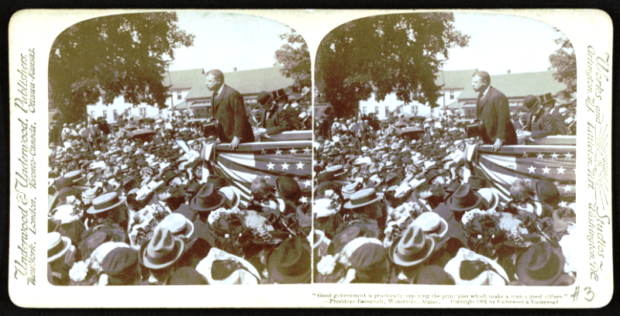This famous family had close ties with Maine from “Teddy” to “FDR.”
Theodore “Teddy” Roosevelt, Jr.
As early as 1878, Teddy Roosevelt began his long relationship with Maine and his personal guide, William Wingate “Bill” Sewall of Island Falls in Aroostook County. They spent a substantial amount of time exploring what is now Katahdin Woods and Waterways National Monument. They maintained their connection as late as August 27, 1902 when Teddy visited Bangor for a speech and invited Bill into his railroad car for a final reunion.
A variant of that encounter is reported by Edmund Morris:
At Bangor, Maine an old loyalty reawakened. “If anyone sees or knows where Bill Sewall of Island Falls, Aroostook is,” Roosevelt yelled from the balcony of the Bangor House, “I wish he would tell him that I want him to come in and lunch with me right now.” The bewiskered woodsman who had toughened him as a teenager pressed dazedly through the crowd, and went inside to roars of applause.
President Roosevelt also visited James G. Blaine on his 1902 tour of Maine, stopping in Waterville as well.
As a supporter of the Progressive party, he wrote a letter to Halbert P. Gardner, the party’s candidate for governor of Maine in 1914:
New York, July 8, 1914
HALBERT P. GARDNER,
Progressive Party Candidate for Governor,
Portland, Me.
My Dear Mr. Gardner:
I am greatly pleased with the fight you and the Progressives of Maine are making. I hope it is unnecessary to say that I shall do everything I can to help in the fight. I shall come to Maine during the campaign and bear testimony on behalf of the cause for which you and I are standing.
I hope you have seen my Pittsburgh speech. In it I think you will see that I have simply applied today to the actual situation as it is the principles for which we fought against such odds two years ago. Then I had to speak in the spirit of prophecy; now I record the fulfillment of the prophecies we then made. Events have shown that this country can never rise level to its opportunities until the principles embodied in the Progressive platform of 1912 are embodied in the law of the land and this embodiment must come by their open and staunch friends. Faithfully yours,
(Signed) THEODORE ROOSEVELT
TR was true to his word, making a visit to Portland and Lewiston on August 18, 1914, riding on new Portland-Lewiston Interurban line electric railway. Portland Monthly, citing “newspaper reports,” noted the excitement of “the crowds that gathered and cheered at stations along the way.”
Franklin and Eleanor Roosevelt
Campobello Island is in Canada, but is accessible by land from Lubec. A large cottage there was the summer retreat of Franklin D. and Eleanor Roosevelt, even before he became President of the United States. Franklin spent summers there from 1885 until he was stricken by polio in 1921.
In the 1930s, Eleanor Roosevelt visited the home of John D. Clifford in Lewiston. Clifford was U.S. Attorney for Maine and an active organizer for the Maine Democratic Party.
On June 23, 1941 Eleanor noted in her “My Day” newspaper column,
Yesterday morning, on the water, it was cool and we had a grand breeze on our way over to Eastport, Maine. Once landed there, we visited various old friends in the fruit store, the drug store and the bank. Then we took a taxi and went out to Quoddy Village to visit the NYA resident project.
I had not seen this project since it had been turned over to the boys. I was impressed by the excellence of the work shops and by the tremendous interest which the boys show in the work they are doing in aviation mechanics and the regular machine shops.
On February 7, 1943 Eleanor Eleanor visited women working at the shipyards in Portland and South Portland, focusing on the challenges of running a home while working.
Additional resources
Addresses and presidential messages of Theodore Roosevelt, 1902-1904. New York. G. P. Putnam’s sons. 1971. p. 32
Erikson, Patricia. “A Streetcar Named Narcissus.” Portland Monthly. Summerguide, 2014. http://www.portlandmonthly.com/portmag/2014/06/a-streetcar-named-narcissus/ (accessed October 24, 2014)
Morris, Edmund. Theodore Rex. New York. Random House. 2001. p. 140.
National Youth Administration. “Quoddy Regional Project, Quoddy Village, Maine.” February 1, 1940. [A brief booklet to describe the goals and methods of the project in employing young men during the Great Depression. http://www.eastport-me.gov/Public_Documents/EastportME_WebDocs/NYA%20140.pdf (accessed October 24, 2014)
“President Roosevelt coming out of the home of former Secretary of State Blaine, Augusta (1902)” Library of Congress, Prints & Photographs Division, [reproduction number, LC-DIG-stereo-1s01973]
“”Good government is practically applying the principles which make a man a good citizen” – President Roosevelt, Waterville, Maine.” Library of Congress, Prints & Photographs Division, [reproduction number, LC-DIG-stereo-1s01955]
Roosevelt, Eleanor. “My Day.” June 23, 1941. From the “My Day” project of George Washington University. http://www.gwu.edu/~erpapers/myday/displaydoc.cfm?_y=1941&_f=md055920 (accessed October 24, 2014)
Vietze, Andrew. Becoming Teddy Roosevelt: How a Maine Guide Inspired America’s 26th President. Rockport, Me. Down East Books. 2010.



